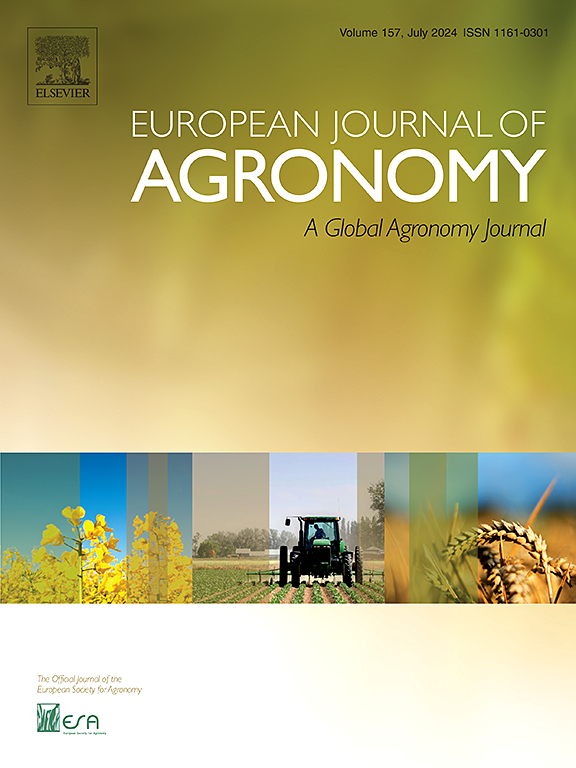作物模型中作物变量和参数的选择——以冬小麦为例
IF 4.5
1区 农林科学
Q1 AGRONOMY
引用次数: 0
摘要
作物模型需要定期更新为新品种的参数化,但这需要校准,这是一个主要挑战。以冬小麦品种Rubisko为例,首次在试验数据上应用一种新的校正方案,利用多试验数据对该新品种的农作物模型参数进行估计。我们在不同条件下测试了校准方案,有或没有LAI和/或生物量实验数据,我们发现得到的LAI和生物量动态强烈分化。本研究通过对拟估变量和参数的选择以及拟定策略的评价标准的研究,有助于为作物模型中新品种的校正提供指导。通过对冬小麦作物模型的应用,本研究表明,校准步骤的选择对模拟输出有重大影响,但对实验数据集的结构有很强的依赖性。首先,本文提出了一种基于三个标准选择校准变量和相关参数的方法:1)估计参数值的相关性,2)均方误差的偏置部分,3)残差分析。其次,通过应用该方法,我们已经表明,在周期结束时观测数据稀疏的情况下,基于LAI测量的校准是最稳健的。基于这些结果,我们建议在包括与辐射利用效率相关的参数时要谨慎;特别是,它们不应该单独与生物量数据上与叶片生长有关的参数一起校准。这项研究使一种适当的校准策略得以确定,这将使更多的现代法国小麦品种能够在STICS作物模型中参数化。本文章由计算机程序翻译,如有差异,请以英文原文为准。
Selecting crop variables and parameters for the calibration of a new cultivar in a crop model: A case study of winter wheat for STICS
Crop models need to be regularly updated with parameterizations for new cultivars, but this requires calibration, which is a major challenge. Using the winter wheat cultivar Rubisko as a case study, we applied for the first time on experimental data a new calibration protocol to estimate the parameters of the STICS crop model for this new cultivar with multi-trial experimental data. We tested the calibration protocol in different conditions, with or without LAI and/or biomass experimental data, and we found that the resulting LAI and biomass dynamics strongly diverged. This study contributes to provide guidance to modelers for the calibration of a new cultivar in a crop model by focusing on the selection of variables and parameters to estimate as well as criteria for evaluating calibration strategies. With an application to winter wheat for the STICS crop model, this study has shown that the choice of calibration steps has a major impact on simulated outputs, but with a strong dependence on the structure of the experimental dataset. Firstly, this paper provides a methodology for the selection of calibration variables and associated parameters based on three criteria: 1) the relevance of the values of the estimated parameters, 2) the bias part of the mean square error, and 3) the analysis of the residuals. Secondly, by applying this methodology, we have shown that calibration based on LAI measurements is the most robust in the case of sparse observed data at the end of the cycle. Based on these results, we recommend caution when including parameters related to radiation-use efficiency; in particular, they should not be calibrated together with parameters related to leaf growth on biomass data alone. This study has enabled an appropriate calibration strategy to be defined, which will allow more modern French wheat cultivars to be parameterized in the STICS crop model.
求助全文
通过发布文献求助,成功后即可免费获取论文全文。
去求助
来源期刊

European Journal of Agronomy
农林科学-农艺学
CiteScore
8.30
自引率
7.70%
发文量
187
审稿时长
4.5 months
期刊介绍:
The European Journal of Agronomy, the official journal of the European Society for Agronomy, publishes original research papers reporting experimental and theoretical contributions to field-based agronomy and crop science. The journal will consider research at the field level for agricultural, horticultural and tree crops, that uses comprehensive and explanatory approaches. The EJA covers the following topics:
crop physiology
crop production and management including irrigation, fertilization and soil management
agroclimatology and modelling
plant-soil relationships
crop quality and post-harvest physiology
farming and cropping systems
agroecosystems and the environment
crop-weed interactions and management
organic farming
horticultural crops
papers from the European Society for Agronomy bi-annual meetings
In determining the suitability of submitted articles for publication, particular scrutiny is placed on the degree of novelty and significance of the research and the extent to which it adds to existing knowledge in agronomy.
 求助内容:
求助内容: 应助结果提醒方式:
应助结果提醒方式:


